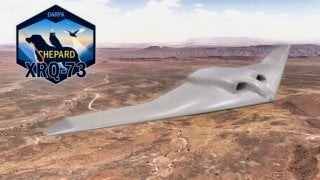XRQ-73: This Looks Like a Mini B-2 Bomber Drone (But It's Even Better)
The Defense Advanced Research Projects Agency (DARPA) has unveiled the XRQ-73, its latest X-plane, an autonomous flying wing reconnaissance aircraft.
Summary and Key Points: The Defense Advanced Research Projects Agency (DARPA) has unveiled the XRQ-73, its latest X-plane, an autonomous flying wing reconnaissance aircraft.
-Part of the Series Hybrid Electric Propulsion Aircraft Demonstration (SHEPARD) program, the XRQ-73 integrates hybrid electric technology with components from the Air Force's Great Horned Owl project. The aircraft, developed with Northrop Grumman and other partners, aims to mature a new long-endurance design quickly.
-The XRQ-73, a Group 3 UAS, is expected to fly by the end of 2024. Speculation suggests it may contribute to the U.S. Air Force's Collaborative Combat Aircraft program, potentially serving as a loyal wingman for future manned fighters.
DARPA Unveiled Its Latest X-Plane – Is It the Future Loyal Wingman?
The Defense Advanced Research Projects Agency has unveiled its newest "X-plane," an autonomous flying wing reconnaissance aircraft.
The XRQ-73 is part of the Series Hybrid Electric Propulsion Aircraft Demonstration (SHEPARD) X-prime program. The program will combine hybrid electric architecture with component technologies derived from the earlier Great Horned Owl (GHO) project of the Air Force Research Laboratory/Intelligence Advanced Research Projects Activity (AFRL/IARPA), DARPA announced.
"The idea behind a DARPA X-prime program is to take emerging technologies and burn down system-level integration risks to quickly mature a new missionized long endurance aircraft design that can be fielded quickly," said Steve Komadina, SHEPARD program manager. "The SHEPARD program is maturing a specific propulsion architecture and power class as an exemplar of potential benefits for the Department of Defense.”
The DARPA team working on the XRQ-73 also includes personnel from AFRL, the Office of Naval Research, and other U.S. military warfighters. Northrop Grumman's Aeronautics Systems is the program's prime contractor. The aerospace firm's subsidiary is working with Cornerstone Research Group, Brayton Energy, PC Krause and Associates, and EaglePicher Technologies to develop the X-plane.
According to DARPA's website for SHEPARD, the program "will leverage the GHO hybrid electric architecture and some of its component technologies," resulting in a "mission-focused aircraft design" able to take its "first flight in 20 months." The new aircraft will be larger than the XRQ-72, the previous GHO X-plane, while still adhering to Group 3 UAS weight restrictions.
The Latest X-plane Explained
Experimental aircraft, or X-planes, are produced to test new technologies and aerospace concepts. In this case, the XRQ-73 aircraft is a Group 3 unmanned aerial system that can fly below 18,000 feet at airspeeds between 100 and 250 knots.
The XRQ-73 utilizes a flying wing design and weighs approximately 1,250 pounds, just under the high end of Group 3's weight range, Air & Space Forces magazine reported. The XRQ-73 is expected to take its first flight by the end of 2024. However, the aircraft had been previously scheduled to make its maiden flight in 2023, but it was delayed for unspecified reasons.
A Loyal Wingman?
Given the larger size of the UAS and its capabilities, there is already speculation it could be related to the U.S. Air Force's Collaborative Combat Aircraft (CCA) program to test, develop, and implement new autonomous aircraft that could fly alongside a future manned fighter.
CCA is part of the air service's larger Next Generation Air Dominance (NGAD) program that seeks to develop a system of systems possibly pairing a sixth-generation manned fighter with an unmanned loyal wingman.
At the Air & Space Forces Association event on June 13, Air Force Chief of Staff Gen. David Allvin addressed the role of the CCA with regard to the NGAD
The CCAs are seen as a key component of NGAD – the drones could support a manned fighter but perform other missions. Allvin reaffirmed that the CCAs would be low-cost, and wouldn't be required to remain in service for 25 or 30 years.
"'Built to last' is a tremendous 20th-century bumper sticker, but the assumption was: whatever you had was relevant as long as it lasted,” Allvin explained. “I'm not sure that's relevant anymore. So that's why we aren't building in a sustainment structure. Ten years after this, I'm hoping the technology will make it so that CCA won't be as relevant, but it might be adaptable, and that's what we're building into modularity and adaptability."
Allvin's comments earlier this month, and Komadina's this week regarding the XRQ-73, do seem to be aligned enough that the XRQ-73 might play a significant role in the development of the CCA loyal wingmen.
Author Experience and Expertise: Peter Suciu
Peter Suciu is a Michigan-based writer. He has contributed to more than four dozen magazines, newspapers, and websites with over 3,200 published pieces over a twenty-year career in journalism. He regularly writes about military hardware, firearms history, cybersecurity, politics, and international affairs. Peter is also a Contributing Writer for Forbes and Clearance Jobs. You can follow him on Twitter: @PeterSuciu. You can email the author: [email protected].

